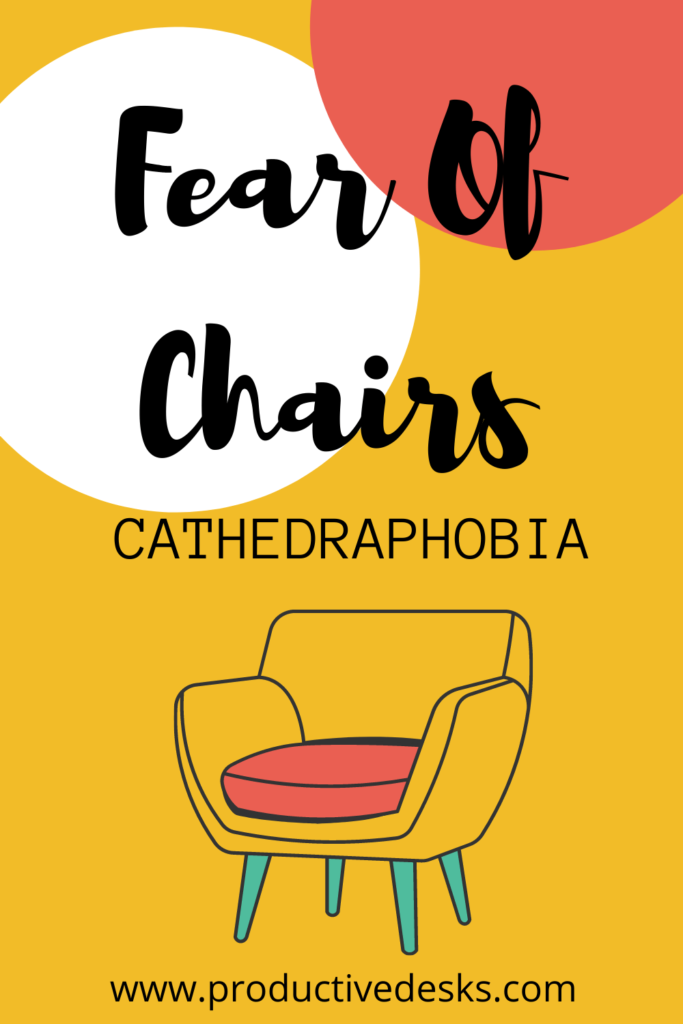Imagine you’re at a party and you have to go to the bathroom. Instead of walking there as most people would, you crawl on the floor, using just your hands and legs.
Would anyone else notice? Maybe they’d just assume you were crawling around because you were drunk or something – but some people might be concerned about your health and think it best to get you checked out by a doctor.
Now imagine that not only do you have to crawl everywhere in public, but when you go home, even to go to bed, you have to lie on the floor instead of using a bed.
This may sound like a joke, but furniture phobia is real. That’s right: Some people have an intense fear of furniture or other objects that are bigger than them.
What is The Fear of Chairs Called?
Cathedraphobia is the fear of chairs, and it is a branch of furniture phobia called Epiplaphobia.
These phobia names have greek roots. According to Wikipedia, the word “Cathedra” means seat, and the word “Epipla” means furniture.
Most people who have Cathedraphobia don’t always feel the need for treatment because they can just avoid the object of their fear. But sometimes, this feeling of control can be hard to find, and avoiding anxiety when seeing chairs might not be enough.
In extreme cases, some people even develop panic attacks just being in rooms with furniture, which could happen without any prior signs or warnings.
Furniture Phobics, in general, are afraid to sit on chairs, recliners, sofas, and couches for fear that they will break down or collapse.
The sight or thought of walking across a piece of furniture is extremely stressful for people with a furniture phobia.
Some even choose not to go shopping with their friends and family if there’s furniture present, such as when looking at couches at IKEA.
It’s not exactly known why some people experience these strong reactions to furniture. Still, it is more common among women than men and seems to be triggered by traumatic events in some cases.
What Are The Symptoms Of Cathedraphobia Branch Of Epiplaphobia?
The symptoms experienced by people with Cathedraphobia can vary in severity.
People with Cathedraphobia might start with avoiding coming into contact with what triggers them to experience fear or anxiety in the first place (which is chairs in this case).
The phobia might increase to the point of being afraid of experiencing anxiety itself because it would make them feel very uncomfortable at the moment they are in contact with any of those.
Things can get to a physical level, and they might start developing panic attacks. These panic attacks can lead to real physical symptoms such as trembling, sweating, nausea, headaches, and rise in blood pressure, and more phobia symptoms.
Strong psychological symptoms might occur when exposed to triggers in some severe cases. They might feel sad and disconnected most of the time, afraid of dread, dying, and fainting. Constantly confused and afraid of losing control.
And because the brain has the ability to generate real feelings and body reactions based on thoughts only, people with furniture phobia don’t necessarily need to be in a situation exposed to chairs to experience Cathedraphobia.
How Do I Overcome My Fear Of Chairs?
To begin with, it is crucial to not ignore your body’s reactions and emotions towards things or situations, research, and seek help before the situation gets more severe and worse. It’s better to admit you have issues and difficulties than ignore them, especially when furniture-related anxiety can affect so many aspects of our lives.
Please, do not take treatment on your own. Always consult with a doctor. Treatments mentioned in this article are general treatments for informational purposes only.
Be aware that there is no guaranteed method to cure phobias. The treatment success depends highly on the person in question and the severity in which that person is experiencing Cathedraphobia, fear of chairs, or Epiplaphobia, fear of furniture.
Talking Treatments
Talking therapies are very helpful because they help patients understand themselves better. They ensure a safe place for the patients to express their feelings without being judged, which helps them a lot in the treatment process.
Cognitive Behavioural Therapy is a talking therapy that can help people with Cathedraphobia manage their phobia by changing how they think and behave. Not only does it involve learning about the mental health condition, but it also includes practicing techniques such as relaxation, resilience, stress management, and assertiveness.
Medication
Medication includes antidepressants, tranquilizers, beta-blockers. But in general, medication is not recommended for overcoming phobias. Research generally shows that psychotherapy is more effective than medications. Adding medications does not significantly improve outcomes from psychotherapy alone.
There are cases that a combination of treatments might be more effective.
The most important thing is to know how to manage thoughts and anxiety. This will not only help a person live or overcome the fear of chairs. But also manage to live will all phobias in general.
To learn more about overcoming furniture-related anxiety, read “The Anxiety and Phobia Workbook” by Edmund J. Bourne or “Rewire Your Anxious Brain: How to Use the Neuroscience of Fear to End Anxiety, Panic, and Worry” by Catherine M. Pittman and Elizabeth M Karle MLIS.
As always, remember not to self-diagnose. Speak with a doctor if you have concerns related to symptoms.
Last but not least, the fear of chairs, chair phobia, or Cathedraphobia is real.
>>> Related : Best Chairs For Back Pain



